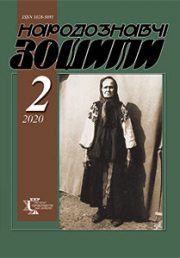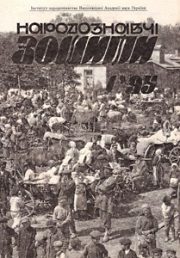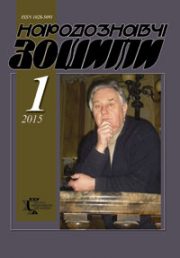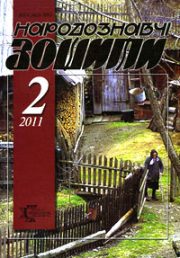The Ethnology Notebooks. 2017, 6 (138), 1425—1432
UDK 061.1:639.1](477.8325)
DOI https://doi.org/10.15407/nz2017.06.1425
Received 28.09.2017
ACTIVITIES OF THE CITY HUNTING SOCIETY IN LVIV
Protsiv Oleg Romanovich, Ph.D. in Public Administration, chief specialist
of Ivano-Frankivsk Regional Department of Forestry and Hunting.
Hrushevsky Str., 31, Ivano-Frankivsk, 76018, Ukraine
Contacts: Tel. (034)2552259; e-mail: oleg1965@meta.ua
Abstract. The article illustrates the activities of the City Hunting Society in Lviv. It is described the management of the society, the number of hunted game, hunting grounds on which hunting was conducted. It is analyzed humanitarian and social component of the society’s activity. It is described peculiarities of hunting by members of the society.
Keywords: Lviv, hunting, public organizations, Galicia.
REFERENCES
Kafka, M. (1934). Z Miejskiego Towarzystwa Myśliwskiego we Lwowie. Łowiec, 8—9, 72.
Krogulski, S. (1924). Јowiectwo polskie pod zaborem austriackim (1872—1918). Łowiec, 1, 4.
Krogulski, S. (1925). Pуі wieku. Łowiec, 2, 18.
Krogulski, S. (1916). Szkic dziejów łowiectwa w Polsce. Łowiec, 9—10, 72—75.
Kronika (1878). Łowiec, 12, 186.
Kronika (1881). Łowiec, 4, 63.
Miejskie towarzystwo myśliwskie: Sprawozdanie łowieckie z sezonu polowań 1937/8. (1938). Łowiec, 13—14, 22.
Miejskie towarzystwo myśliwskie we Lwowie. (1938). Łowiec, 7—8, 19.
Na ołtarz sw. Huberta w daluszym ciagu zlozyli. (1925). Łowiec, 11, 4.
Na strzelnicy. (1910). Łowiec, 13, 151.
Nekrolog. (1913). Łowiec, 14, 167.
Nekrolog. (1915). Łowiec, 17—18, 143.
Nekrolog. (1923). Łowiec, 9, 143.
Nekrolog. (1935). Łowiec, 4, 44.
Nekrolog. (1937). Łowiec, 14, 215.
Ogłoszenia. (1918). Gazeta lwowska, 219, 14.
Ogłoszenia. (1918). Łowiec, 19—20, 159.
Ogłoszenia. (1932). Łowiec, 8, 110.
Ogłoszenia. (1935). Łowiec, 12, 156.
Ogłoszenia. (1926). Łowiec, 6, 95.
Ogłoszenia. (1929). Łowiec, 22, 340.
Ogłoszenia. (1933). Łowiec, 18, 216.
Ogłoszenia. (1934). Łowiec, 17—18, 148.
Ogłoszenia. (1934). Łowiec, 21—22, 179.
Ogłoszenia. (1919). Gazeta lwowska, 249, 8.
Ogłoszenia. (1912). Łowiec,19, 228.
Polowania w cyfrach (miesiące: grudzień 1937 i styczeń 1938). (1938). Łowiec, № 3—4, 40.
Regulamin popisowego strzelania uczestników Zjazdu łowieckiego, urządzonego przez galicyjskie Towarzystwo łowieckie w dniu 25. czerwca 1900 o godzinie pół do 4. po południu na strzelnicy wojskowej. (1900). Łowiec, 12, 173.
Regulamin popisowego strzelania uczestników Zjazdu łowieckiego, urządzonego przez galicyjskie Towarzystwo łowieckie w dniu. 25. czerwca 1901 o godzinie pół do 4. po południu na strzelnicy wojskowej. (1901). Łowiec, 12, 173.
Regulamin popisowego strzelania uczestników Zjazdu łowieckiego, urządzonego przez galicyjskie Towarzystwo łowieckie w dniu I. lipca 1901 o godzinie pół do 4. po południu na strzelnicy wojskowej. (1901). Łowiec, 12, 175.
Regulamin popisowego strzelania uczestników Zjazdu łowieckiego, urządzonego przez galicyjskie Towarzystwo łowieckie w dniu 30. czerwca 1902 o godzinie 3. po południu na strzelnicy wojskowej. (1902). Łowiec, 12, 139.
wozdanie z posiedzenia Wydziału z dnia 1/IV.1922. (1922). Łowiec, 5, 9.
Sprawy Towarzystwa. (1922). Łowiec, 10, 13.
Till, E. (1892). Wykład prawa rzeczowego ausriyackiego (prawo własności, prawo służebności i prawo zastawu) (Vol. 2, pp. 177—184). Lwów : Nakładem księgarni Seyfartha i Czajkowskiego.
Z knieje miejskiej. (1894). Łowiec, 3, 41.
Z rewirow miejskiego Tow. myśl. we Lwowie. (1922). Łowiec, 3, 4.
Zające i inna zwieryna na ulicach Lwowa. (1943). Gazeta lwowska, 295, 3.
Zaklika, Z. (1939). Miejskie towarzystwo myśliwskie we Lwowie. Łowiec, 11—12, 112—113.
Zawody strzeleckomyśliwskie Małopolskiego towarzystwa łowieckiego. (1938). Łowiec, 13—14, 22.







